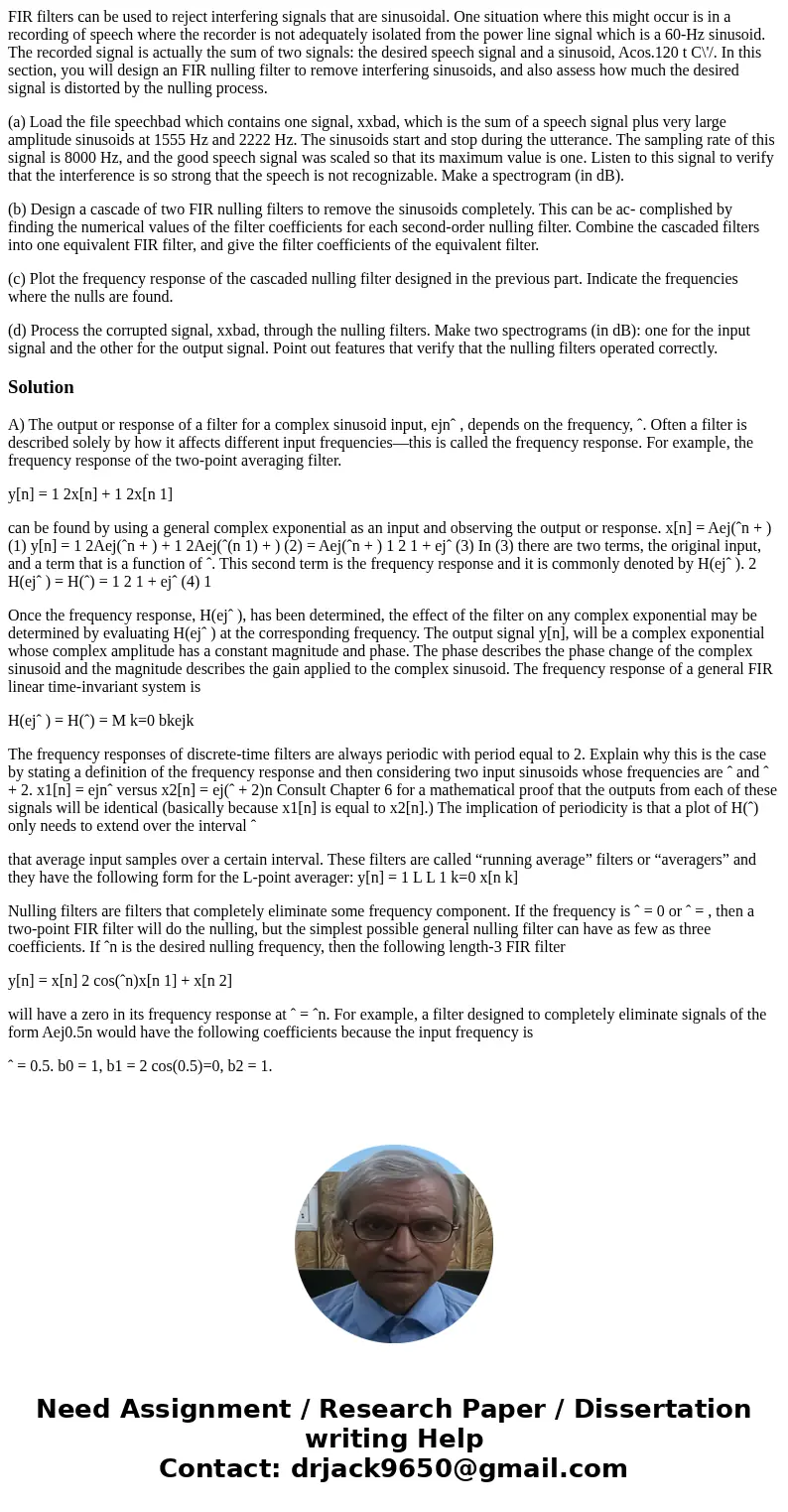FIR filters can be used to reject interfering signals that a
FIR filters can be used to reject interfering signals that are sinusoidal. One situation where this might occur is in a recording of speech where the recorder is not adequately isolated from the power line signal which is a 60-Hz sinusoid. The recorded signal is actually the sum of two signals: the desired speech signal and a sinusoid, Acos.120 t C\'/. In this section, you will design an FIR nulling filter to remove interfering sinusoids, and also assess how much the desired signal is distorted by the nulling process.
(a) Load the file speechbad which contains one signal, xxbad, which is the sum of a speech signal plus very large amplitude sinusoids at 1555 Hz and 2222 Hz. The sinusoids start and stop during the utterance. The sampling rate of this signal is 8000 Hz, and the good speech signal was scaled so that its maximum value is one. Listen to this signal to verify that the interference is so strong that the speech is not recognizable. Make a spectrogram (in dB).
(b) Design a cascade of two FIR nulling filters to remove the sinusoids completely. This can be ac- complished by finding the numerical values of the filter coefficients for each second-order nulling filter. Combine the cascaded filters into one equivalent FIR filter, and give the filter coefficients of the equivalent filter.
(c) Plot the frequency response of the cascaded nulling filter designed in the previous part. Indicate the frequencies where the nulls are found.
(d) Process the corrupted signal, xxbad, through the nulling filters. Make two spectrograms (in dB): one for the input signal and the other for the output signal. Point out features that verify that the nulling filters operated correctly.
Solution
A) The output or response of a filter for a complex sinusoid input, ejnˆ , depends on the frequency, ˆ. Often a filter is described solely by how it affects different input frequencies—this is called the frequency response. For example, the frequency response of the two-point averaging filter.
y[n] = 1 2x[n] + 1 2x[n 1]
can be found by using a general complex exponential as an input and observing the output or response. x[n] = Aej(ˆn + ) (1) y[n] = 1 2Aej(ˆn + ) + 1 2Aej(ˆ(n 1) + ) (2) = Aej(ˆn + ) 1 2 1 + ejˆ (3) In (3) there are two terms, the original input, and a term that is a function of ˆ. This second term is the frequency response and it is commonly denoted by H(ejˆ ). 2 H(ejˆ ) = H(ˆ) = 1 2 1 + ejˆ (4) 1
Once the frequency response, H(ejˆ ), has been determined, the effect of the filter on any complex exponential may be determined by evaluating H(ejˆ ) at the corresponding frequency. The output signal y[n], will be a complex exponential whose complex amplitude has a constant magnitude and phase. The phase describes the phase change of the complex sinusoid and the magnitude describes the gain applied to the complex sinusoid. The frequency response of a general FIR linear time-invariant system is
H(ejˆ ) = H(ˆ) = M k=0 bkejk
The frequency responses of discrete-time filters are always periodic with period equal to 2. Explain why this is the case by stating a definition of the frequency response and then considering two input sinusoids whose frequencies are ˆ and ˆ + 2. x1[n] = ejnˆ versus x2[n] = ej(ˆ + 2)n Consult Chapter 6 for a mathematical proof that the outputs from each of these signals will be identical (basically because x1[n] is equal to x2[n].) The implication of periodicity is that a plot of H(ˆ) only needs to extend over the interval ˆ
that average input samples over a certain interval. These filters are called “running average” filters or “averagers” and they have the following form for the L-point averager: y[n] = 1 L L 1 k=0 x[n k]
Nulling filters are filters that completely eliminate some frequency component. If the frequency is ˆ = 0 or ˆ = , then a two-point FIR filter will do the nulling, but the simplest possible general nulling filter can have as few as three coefficients. If ˆn is the desired nulling frequency, then the following length-3 FIR filter
y[n] = x[n] 2 cos(ˆn)x[n 1] + x[n 2]
will have a zero in its frequency response at ˆ = ˆn. For example, a filter designed to completely eliminate signals of the form Aej0.5n would have the following coefficients because the input frequency is
ˆ = 0.5. b0 = 1, b1 = 2 cos(0.5)=0, b2 = 1.

 Homework Sourse
Homework Sourse